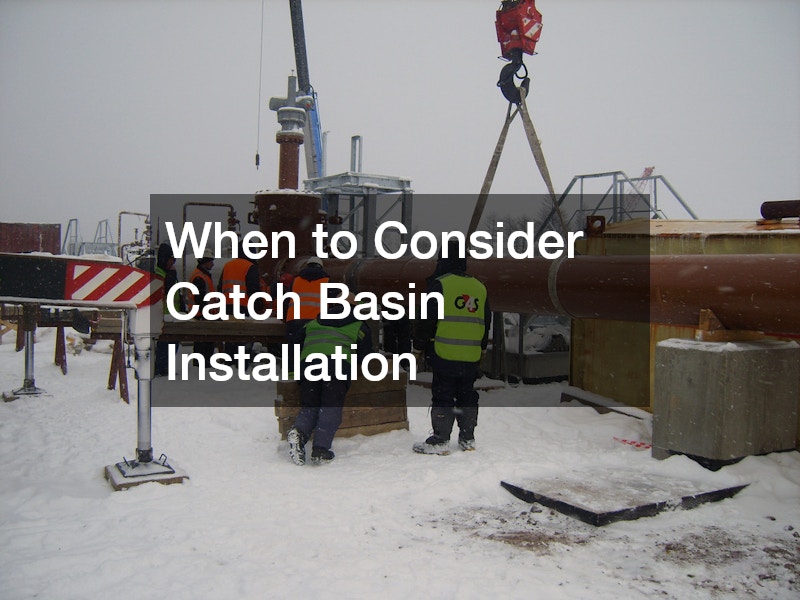When it comes to managing stormwater and preventing water damage around buildings, roads, and landscapes, few tools are as effective as a catch basin. These underground drainage structures play a crucial role in directing excess water away from areas where it can cause erosion, flooding, or foundation damage. But what exactly is a catch basin, and how does it work?
What Is a Catch Basin?
A catch basin is a type of drainage structure designed to collect and redirect surface water runoff. Typically made of concrete or plastic, it sits below ground level and features a grate on top that allows water to flow in. Beneath the grate is a sump area where debris like leaves, trash, and sediment settle before the water continues through an underground drainage system.
This separation of solids from water helps prevent blockages in the pipes connected to the basin, maintaining an efficient flow of water away from streets, driveways, lawns, and parking lots.
How Do Catch Basins Work?
Catch basins work as part of a larger stormwater management system. As rainwater flows over hard surfaces like pavement or driveways, it carries debris and pollutants along with it. The water enters the catch basin through the top grate and collects in the basin’s sump. Heavier debris sinks to the bottom, while the water continues through a series of pipes connected to the municipal storm sewer or another designated drainage outlet.
This process reduces the risk of flooding during heavy rainfall and helps control erosion by slowing down and redirecting the flow of water. It also minimizes the amount of debris that enters the drainage system, reducing the need for frequent maintenance.
Common Locations for Catch Basin Installation
Catch basins are found in a variety of settings, each with the goal of managing stormwater effectively. Some of the most common locations include:
-
Residential driveways: To prevent water from pooling near garages or foundations.
-
Parking lots: To channel large volumes of water safely away from vehicles and structures.
-
Street corners: To catch runoff from roads and sidewalks.
-
Low-lying areas in landscapes: To collect and redirect water from areas prone to saturation or flooding.
In any of these locations, proper catch basin installation ensures that water is managed efficiently and directed away from sensitive or vulnerable zones.
Key Components of a Catch Basin System
Understanding the components of a catch basin helps highlight how it functions so effectively:
-
Grate: The visible part of the catch basin that allows water to enter. Grates are typically made of metal and are strong enough to support foot or vehicle traffic.
-
Basin or Sump: This is the main chamber beneath the grate that collects water and allows heavier materials to settle out.
-
Outlet Pipe: This pipe carries the filtered water from the basin to a storm drain, retention pond, or other approved drainage point.
-
Sediment Trap: An optional feature that further enhances the basin’s ability to remove debris before water exits.
All of these components work together to ensure that the basin performs its role in flood prevention and water management.
Benefits of Catch Basin Installation
Installing a catch basin offers several advantages for both residential and commercial properties:
-
Flood Prevention: By collecting excess runoff, catch basins prevent water from pooling in unwanted areas.
-
Erosion Control: Redirecting water flow helps protect landscapes and hardscapes from erosion.
-
Foundation Protection: Prevents water from seeping into basements or damaging building foundations.
-
Cleaner Stormwater Systems: Catch basins filter out trash and debris before water enters the public stormwater infrastructure.
-
Improved Safety: Reducing standing water helps prevent slippery surfaces and mosquito breeding grounds.
Whether you’re managing a residential lawn or a large commercial parking lot, catch basin installation plays a vital role in maintaining property safety and longevity.
Maintenance Matters
While catch basins are highly effective, they do require regular maintenance to remain functional. Over time, the sump can fill with sediment and debris, reducing its capacity and leading to clogs. Routine inspections and cleanouts ensure that water flows freely and the system remains efficient.
Maintenance usually involves removing the grate and clearing out the accumulated debris from the bottom of the basin. In some cases, professionals use vacuum trucks or pressure washers for thorough cleaning, especially in areas with heavy rainfall or debris buildup.
When to Consider Catch Basin Installation
If you notice standing water on your property after rain, pooling around your foundation, or erosion along your landscaping, it may be time to consider catch basin installation. This is particularly important in areas with poor natural drainage, heavy rainfall, or sloped terrain.
Even in newer developments, improper water flow can lead to long-term damage if not addressed. Installing a catch basin can provide peace of mind, especially during severe weather events, by managing runoff and preserving the structural integrity of your property.
Catch basins may not be the most visible feature of a property, but they are among the most important when it comes to managing water flow and protecting infrastructure. Whether on a busy commercial site or a quiet suburban driveway, these unassuming structures offer powerful protection against flooding, erosion, and water damage.
If you’re considering improving your property’s drainage, professional catch basin installation is a reliable and long-lasting solution.




